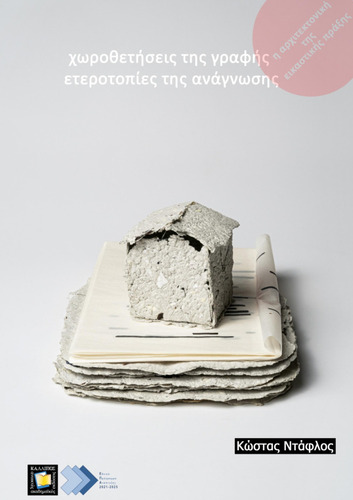Table of Contents - Adobe PDF
(392.54 kB)
Adobe PDF
(37.67 MB)
Adobe PDF
(1.68 MB)
Brochure
Download
| Title Details: | |
|
Spatial settings of writing, heterotopias of reading |
|
| Other Titles: |
Τhe architecture of art praxis |
| Authors: |
Daflos, Kostas |
| Subject: | HUMANITIES AND ARTS > LINGUISTICS > FIELDS OF LINGUISTICS > FIELDS RELATED TO THE MEANING OF LANGUAGE > DISCOURSE ANALYSIS/TEXT LINGUISTICS > DISCOURSE ANALYSIS/TEXT LINGUISTICS HUMANITIES AND ARTS > LINGUISTICS > FIELDS OF LINGUISTICS > APPLIED LINGUISTICS > READING PROCESSES HUMANITIES AND ARTS > LINGUISTICS > FIELDS OF LINGUISTICS > FIELDS BY PHYSICAL ASPECTS OF LANGUAGE AND COMMUNICATION > NONVERBAL COMMUNICATION > ART AS LANGUAGE HUMANITIES AND ARTS > ARTS AND LETTERS > VISUAL ARTS HUMANITIES AND ARTS > ARTS AND LETTERS > VISUAL ARTS > ARCHITECTURE > ARCHITECTURAL MODELS HUMANITIES AND ARTS > ARTS AND LETTERS > VISUAL ARTS > GRAPHIC ARTS > CALLIGRAPHY > PENMANSHIP HUMANITIES AND ARTS > ARTS AND LETTERS > VISUAL ARTS > HANDICRAFTS HUMANITIES AND ARTS > PHILOSOPHY > BASIC PHILOSOPHICAL CONCEPTS > REPRESENTATION |
| Keywords: |
Reading
Site-Writing Visual Spatial Miniatures Text Pastiche Heterotopia Archetype Daydreaming Nomadism Labyrinth Patchwork Palimpsest Critical Spatial Practices Situated writing |
| Description: | |
| Abstract: |
The book pursues a writing from many voices and from many languages, which address how literature and art are able to introduce tools and methods into theoretical research, as well as how material spatial (critical) practices allow possibilities of transferring writing, 'voices' and 'images' from texts to other places of meaning (as in visual micrographs). In this context, physical location becomes text in the processes of site-specific writing, which (the text) itself has many different specific sites that can become objects of processing. The artistic subject in the threshold position of "writer and reader" at the interface of an internal dialogue (with the self), as well as an external one (with the referential personal and collective "library"), in the context of the textual relations involved (both trans-poetic and intra-poetic), interposes creative inventive mechanisms, different methods or tactics of writing (potential literature, surrealistic, etc.), and also different techniques and modes of reading (e.g. imaginative, unconscious, of lost characters, poetic misreading, etc.) via archetypal patterns (such as labyrinth, rhizome, circular and linear routines, etc.). The entangled "image" of imagination and memory that arises in daydreaming meets the performative handmade realization of materiality in the constructional acts. The Appendix in this book presents the plastic spatiality of the text, in the times of the workshops in the laboratory, as embodied gestures with applied technologies on the page as so as performative praxis around the paper. The spatial micrographs (miniatures) correspond to the mirrored (heterotopic) constitution of personal microcosms.
|
| Linguistic Editors: |
Kioseoglou, Nerina |
| Graphic Editors: |
Kotzampasi, Dora |
| Other contributors: |
Φωτογραφία εξωφύλλου: Θάνος Παπαδόπουλος Cover photograph: Thanos Papadopoulos |
| Type: |
Undergraduate textbook |
| Creation Date: | 01-12-2023 |
| Item Details: | |
| ISBN |
978-618-228-160-4 |
| License: |
Attribution - NonCommercial - ShareAlike 4.0 International (CC BY-NC-SA 4.0) |
| DOI | http://dx.doi.org/10.57713/kallipos-392 |
| Handle | http://hdl.handle.net/11419/11655 |
| Bibliographic Reference: | Daflos, K. (2023). Spatial settings of writing, heterotopias of reading [Undergraduate textbook]. Kallipos, Open Academic Editions. https://dx.doi.org/10.57713/kallipos-392 |
| Language: |
Greek |
| Consists of: |
1. Introduction 2. On the threshold of the subjects of writing and reading 3. The Art of Reading Constructionism 4. Processes of textual spatialization in the literature of spatiality 5. Spatial micrographies as heterotopy and textual heterochrony 6. The travels of writing and reading (textual travelogue) 7. Heterotopias of reading - transformations of text into three-dimensional material units 8. Postproductions of texts towards the constitution of meaningful spatiality (the emergence of meaning) 9. Archival practices in performative material realisation 10. Polyphony and heterophony in the performance of dialogical text 11. Everyday life with things as the raw material 12. Handcrafted experiential tactics 13. Appendix |
| Number of pages |
377 |
| Publication Origin: |
Kallipos, Open Academic Editions |
| You can also view | |
| User comments | |
There are no published comments available! | |

